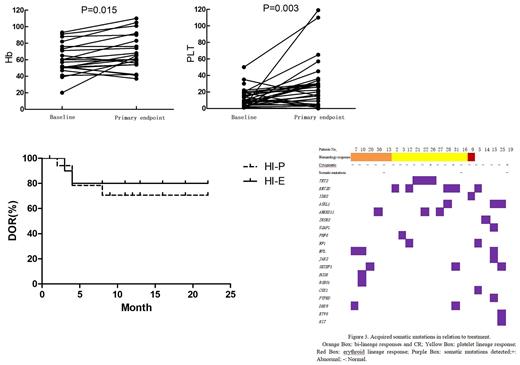Abstract
Objective: Myelodysplastic syndromes (MDS) are a heterogeneous group of clonal myeloid disorders characterized by ineffective hematopoiesis and cytopenias, with variable risks of progression to acute myelogenous leukemia (AML). Peripheral blood cytopenias are the major sources of morbidity and mortality for lower-risk MDS (LR-MDS) pts.The strategies guided by risk stratification tools are different for HR- and LR-MDS. The treatment options for cytopenias in IST non-responders, especially thrombocytopenia, are limited. Such pts are prone to a high risk of bleeding. Eltrombopag (EPAG) is an orally administered nonpeptide thrombopoietin (TPO) receptor agonist. The single-agent activity of EPAG was demonstrated in 44-47% of pts with LR-MDS . In this study, we investigated the efficacy and safety of the combination of EPAG and CysA in LR-MDS in a non-randomized phase II investigator-initiated trial. Method(s):Pts with a diagnosis of LR-MDS by WHO 2016 classification and IPSS-R as low to intermediate-risk group with hemoglobin (Hb) <9.0 g/dL, or RBC transfusion-dependence (at least four units of RBC at 8 weeks prior to enrollment); platelet count <20×109/L or platelet transfusion dependence; were enrolled. http://www.chictr.org.cn/ identifier: ChiCTR2000035473. The primary objective of this IIT was to evaluate the response to this regimen based on IWG-MDS 2006 criteria. Results All the 31 pts were evaluated for response at the primary endpoint. Among them, 21 (67.7%) pts achieved treatment response in at least one eligible lineage with an objective response rate (ORR), 4 (12.9%) pts achieved a CR, 5 (16.1%) pts achieved bi-lineage responses (HI-PE R), 11 (24.3%) pts achieved platelet lineage responses (HI-P R), and 1 (3.2%) patient achieved erythroid lineage response (HI-E R). ANC did not increase significantly at the primary endpoint compared to the baseline; however, altered ANC was a response of CR pts. The median time to response was 8 (range, 2-24) weeks, irrespective of whether the pts had a platelet or erythroid response.Of the 21 pts eligible for an erythroid lineage response,10 pts (47.6%) had responded by the endpoint and the platelet response rate was 64.5% (20/31). The median increase in Hb levels and platelets was from 60.4±18.2 g/L to 68.0±21.2 g/L (P=0.015) and from 12.3±11.2×109/L to 32.5±37.3×109/L (P=0.003) (Figure 1). The median DORs of HI-E and HI-P were not achieved, but the response rates of erythroid and platelet lineages in 20 months were 80.0% and 70.6%, respectively (Figure 2). The RBC and platelet transfusion-dependent rate decreased from 42.9% (9/21) to 28.6% (6/21) (P=0.334) and from 58.0% (18/31) to 25.8% (8/31)We also performed targeted next-generation exome sequencing of 80 genes associated with myeloid malignancies in 21 pts. Among them, 18 showed a total 19 somatic mutations (Figure 3). TET2,and ANKRD11 were detected in 3 responding pts,and KMT2D was detected in 3 responding pts. Pts with adverse prognostic genes, such as ASXL1, ARSR2, U2AF1, KIT, and ETV6, did not exhibit a hematological response. Somatic mutations in DHX9 and ROBO1 were associated with BM failure, as detected in responding pts. All 31 pts were evaluated for toxicity, and the treatment was found to be well-tolerated. The most commonly reported adverse events (AEs) of any grade were nausea (6/31,19.4%), elevated liver transaminases (4/31,12.9%), and headache (3/31,9.7%); no severe AEs had been reported until the cutoff date. One MDS-SLD patient who received CR at 3 weeks experienced deep venous thrombosis of the lower extremity after 9 months of medication, thereby requiring dose interruption. After anticoagulant therapy, the platelet count was still 65×109/L. One MDS-U case who received HI-P had increased BM blasts from 3.2% to 15.4% for 4 months. Another MDS-U case received HI-E and HI-P, and the chromosome was changed from normal karyotype to -7/del (20q) chimeric karyotype for 9 months after administration of the drugs. However, the hematological response was maintained for 16 months until the cutoff date for data collection. Conclusions: Our results indicated that the addition of Epag to CysA is well-tolerated and is an effective treatment for LR-MDS. These ORR are better than CysA monotherapy, especially HI-P. Also, the hematological responses are durable, although continued Epag administration might be necessary.
Disclosures
Wang:AstraZeneca: Consultancy; Abbvie: Consultancy, Membership on an entity's Board of Directors or advisory committees.
Author notes
Asterisk with author names denotes non-ASH members.


